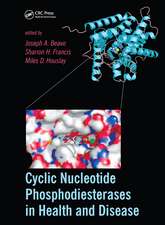Landmark Experiments in Molecular Biology
Autor Michael Fryen Limba Engleză Paperback – 7 iul 2016
- Includes detailed analysis of classically designed and executed experiments
- Incorporates technical and scientific analysis along with historical background for a robust understanding of molecular biology discoveries
- Provides critical analysis of the history of molecular biology to inform the future of scientific discovery
- Examines the machinery of inheritance and biological information handling
Preț: 559.55 lei
Preț vechi: 642.24 lei
-13% Nou
Puncte Express: 839
Preț estimativ în valută:
107.07€ • 112.09$ • 88.59£
107.07€ • 112.09$ • 88.59£
Carte tipărită la comandă
Livrare economică 29 martie-12 aprilie
Preluare comenzi: 021 569.72.76
Specificații
ISBN-13: 9780128020746
ISBN-10: 0128020741
Pagini: 570
Ilustrații: 150 illustrations (150 in full color)
Dimensiuni: 152 x 229 x 32 mm
Greutate: 0.95 kg
Editura: ELSEVIER SCIENCE
ISBN-10: 0128020741
Pagini: 570
Ilustrații: 150 illustrations (150 in full color)
Dimensiuni: 152 x 229 x 32 mm
Greutate: 0.95 kg
Editura: ELSEVIER SCIENCE
Cuprins
CHAPTER 1: IntroductionCHAPTER 2: Prehistory of Molecular Biology: 1847-1944CHAPTER 3: Avery Identifies DNA as the Genetic MaterialCHAPTER 4: Hershey and Chase Clinch the Role of DNA as the Genetic MaterialCHAPTER 5: Watson and Crick Solve the Structure of DNACHAPTER 6: Meselson and Stahl Demonstrate that DNA is Replicated SemiconservativelyCHAPTER 7: Defining the Genetic CodeCHAPTER 8: The Adaptor Hypothesis and the Isolation of transfer RNACHAPTER 9: The Discovery and Rediscovery of messenger RNACHAPTER 10: Deciphering the Genetic CodeCHAPTER 11: The Surprising Discovery of Split Genes and RNA SplicingChapter 12: Epilogue, Theory-driven versus experiment-directed discoveries in molecular biology
Recenzii
"The title of the book perfectly summarizes Michael Fry’s aim: to present in a simple educational way the most beautiful and significant experiments in the history of molecular biology. The most significant contribution of this publication is probably the beautiful and precise experimental illustrations that have been specially drawn to accompany an equally precise and complete description of the experiments described in the book. Michael Fry has also added a long list of references, to the original articles, to the comments made by the scientists involved, and to the work of historians. This book will be useful, but the historian will not be wholly happy with it. What is missing.... in the book in general, is a meta-level of interpretation not limited to that of the participants, a meta-level mixing analysis of the context, philosophical issues not limited to the too general debate on the opposition between theory and experiment, and a precise study of the dynamics of the events that led to the discovery. Maybe Michael Fry was too modest and too admiring of the work that was accomplished to do what a historian would expect: resurrect the context that even the participants have often forgotten and sometimes never clearly distinguished, to show how tortuous the pathway of discovery was, how the ideas that led to the truth were often wrong. This ‘unvarnished’ history, leaving as much space to mistakes as to successes, is the only one that can be truly useful to future scientists." -- Professor Michel Morange, History and Philosophy of the Life Sciences



















